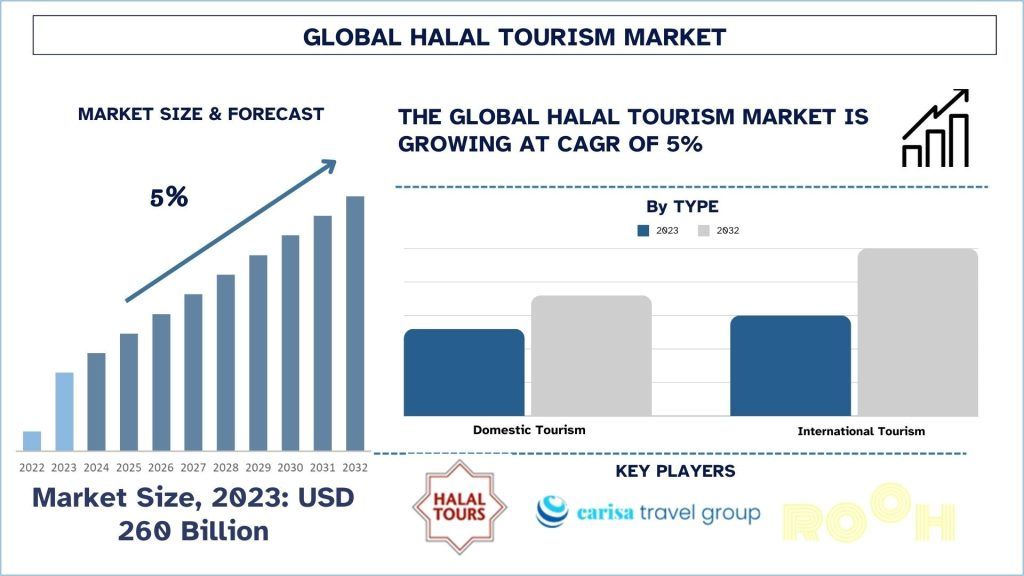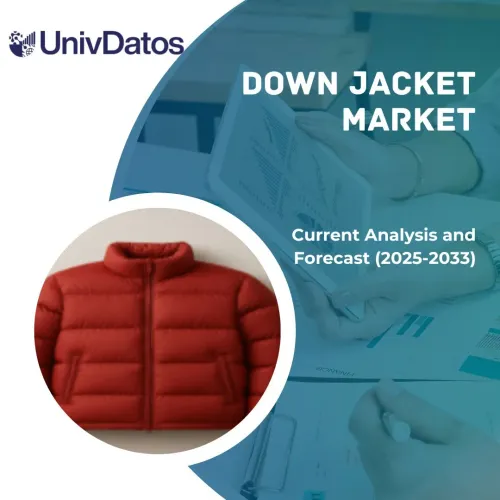- Strona główna
- O nas
- Branża
- Usługi
- Czytanie
- Kontakt
Rynek Turystyki Halal: Bieżąca Analiza i Prognoza (2024-2032)
Nacisk na rodzaj (Turystyka krajowa, Turystyka międzynarodowa); Rodzaj turysty (Indywidualny, Grupa turystyczna i Turysta zorganizowany); Kraj (Zjednoczone Emiraty Arabskie, Arabia Saudyjska, Iran, Katar, Kuwejt, Malezja, Indonezja, Singapur, Wielka Brytania i Reszta Świata)
Wielkość rynku turystyki halal i prognozy
Wartość rynku turystyki halal wyniosła w 2023 roku około 260 miliardów USD i oczekuje się, że w okresie prognozy (2024-2032) będzie rósł w znacznym tempie CAGR wynoszącym około 5%, ze względu na rosnący popyt konsumentów na zrównoważone opcje żywnościowe.
Analiza rynku turystyki halal
Turystykę halal można zdefiniować jako usługi turystyczne, które zaspokajają potrzeby muzułmanów zgodnie z nakazami islamu. Obejmują one oferowanie jedzenia halal, brak serwowania napojów alkoholowych, miejsca do modlitwy i medytacji, skromność w układzie zakwaterowania oraz oddzielanie płci, ras i grup etnicznych zgodnie z islamskim prawem szariatu. Turystyka halal gwarantuje, że muzułmanie zainteresowani podróżowaniem będą mogli to robić bez naruszania żadnych zasad religijnych, które są im drogie.
Populacja muzułmańska na świecie rośnie, a szczególnie w regionach o wyższym dochodzie na mieszkańca wzrasta konsumpcja usług turystyki halal. Zgodnie z danymi American Halal Foundation (USA), w 2024 roku muzułmańscy konsumenci na całym świecie wydali oszałamiającą kwotę 2 bilionów USD, a oczekuje się, że do 2025 roku wzrośnie ona do 2,8 bilionów USD. Populacja muzułmańska jest niezwykle młoda, a około 30% z 2 miliardów muzułmanów ma od 15 do 29 lat. Ponadto wzrost świadomości muzułmanów o dostępności usług turystyki halal i specjalistycznych portali ułatwił im wybór. Ponadto, globalne destynacje podążają za tym rynkiem, zapewniając restauracje halal, miejsca kultu i hotele przyjazne islamowi. Ma to wpływ na sektor hotelarski, a zatem na rozszerzenie usług, co może pozytywnie wpłynąć na konkurencyjność rynku i rozwój turystyki w krajach o niewielkiej populacji muzułmańskiej.
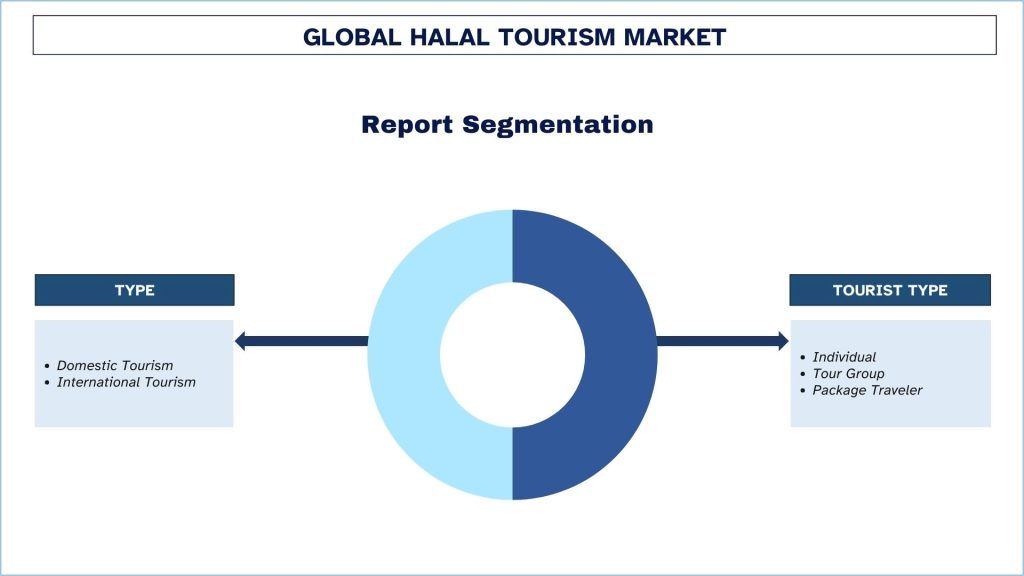
Trendy na rynku turystyki halal
W tej sekcji omówiono kluczowe trendy rynkowe wpływające na różne segmenty rynku turystyki halal, zidentyfikowane przez naszych ekspertów ds. badań.
Turystyka międzynarodowa przekształca branżę turystyki halal.
Turystyka międzynarodowa odgrywa znaczącą rolę w penetracji i dominacji globalnego rynku turystyki halal, ponieważ populacja muzułmańska rozszerza się w poszukiwaniu podróży zgodnych z wiarą islamską. Podczas gdy podróżowanie pozostaje luksusem w wielu częściach świata, globalni gracze dostosowują się do rynków wschodzących, oferując autentyczne jedzenie halal, usługi modlitewne i napoje bezalkoholowe. Ta adaptacja nie tylko służy celowi, jakim jest dotarcie do muzułmańskich klientów, ale także zwiększa atrakcyjność marek dla zróżnicowanych klientów, co jest korzystne dla biznesu. Rządy i prywatni inwestorzy wydają pieniądze na programy marketingowe skierowane do krajów z większością populacji muzułmańskiej, demonstrując w ten sposób swoją gotowość do zaspokojenia potrzeb halal, co zwiększa atrakcyjność atrakcji turystycznych. Pomaga to w ujawnieniu znaczącej niszy rynkowej i stymuluje rozwój finansowy branży turystycznej, dywersyfikując jednocześnie świadczone usługi. Przyjęcie turystyki halal oznacza spełnienie standardów międzynarodowych podróży, przyspiesza postrzeganie doskonałości usług, przyciąga szerszy zakres klientów i sprzyja powtarzalności biznesu. Na przykład, American Halal Foundation (AHF) jest wiodącą, akredytowaną na arenie międzynarodowej i akceptowaną na całym świecie agencją certyfikacji halal w Ameryce Północnej, która osiągnęła ponad 1 miliard USD wzrostu biznesu dzięki certyfikacji halal AHF w ciągu 10 lat.
Malezja liderem na rynku.
Malezja skutecznie promuje się jako globalne centrum turystyki halal, wykorzystując swoją dominującą demografię muzułmańską i zaawansowany przemysł halal. Tourism Malaysia zachęca również muzułmańskich turystów do odwiedzenia tego kraju poprzez swój slogan marketingowy „Malaysia, Truly Asia”, który przedstawia Malezję jako kraj oferujący jedzenie halal, zakwaterowanie zgodne z islamskim prawem szariatu oraz usługi rozrywkowe dla rodzin i młodzieży. Malezja posiada rozbudowany system certyfikacji halal dla produktów, usług, hoteli i restauracji, dzięki czemu turyści akceptują ją, ponieważ przestrzega islamskiego prawa szariatu. Odgrywa również rolę w organizowaniu globalnych forów i wystaw halal, przyczyniając się do promocji wizerunku kraju jako destynacji turystyki halal. Taki nacisk na zgodność z zasadami halal służy nie tylko kulturowemu i religijnemu zapotrzebowaniu turystów muzułmańskich, ale także prowokuje lokalną i międzynarodową turystykę, co z kolei pomaga w rozwoju gospodarki narodowej. Malezja zatem kontynuuje rozwijanie tej siły poprzez dostosowywanie polityki i udogodnień przyjaznych halal i korzystanie z ciągłego wzrostu globalnego rynku turystyki halal.
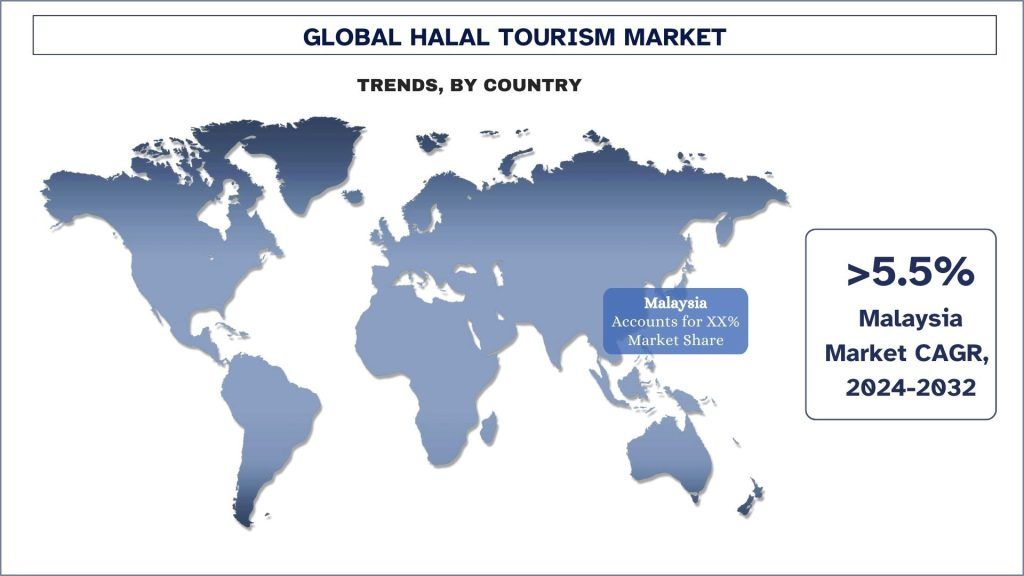
Przegląd branży turystyki halal
Rynek turystyki halal jest konkurencyjny, z udziałem kilku globalnych i międzynarodowych graczy. Kluczowi gracze przyjmują różne strategie wzrostu, aby wzmocnić swoją obecność na rynku, takie jak partnerstwa, umowy, współpraca, wprowadzanie nowych produktów, ekspansja geograficzna oraz fuzje i przejęcia. Niektórzy z głównych graczy działających na rynku to Beyond halaltours.org, Carisa Travel Group, Rooh Travel Limited, Halalbooking., Halal Safaris, Halal Trip India, Hello Travel Pte Ltd., mazhoudhalaltourism.com, Rihaala.com (Serendipity Tailormade Ltd), Tripfez.
Wiadomości z rynku turystyki halal
W 2024 roku Tajlandia zatwierdziła kilka inicjatyw w nadziei na to, że do 2028 roku stanie się nowym centrum halal w Azji Południowo-Wschodniej, promując dalej tajskie jedzenie i inne produkty na całym świecie, jednocześnie wzmacniając turystykę królestwa.
W 2024 roku – lipcowe aktywności Nova Maldives zostały dostosowane do potrzeb podróżników samotnych. Obniżone ceny są również w planach dla osób podróżujących samotnie, z rabatami do 45 procent i cenami od 1795 Dh (488 USD) za osobę za noc.
Zakres raportu o rynku turystyki halal
Atrybut raportu | Szczegóły |
Rok bazowy | 2023 |
Okres prognozy | 2024-2032 |
Dynamika wzrostu | Przyspieszenie przy CAGR wynoszącym 5% |
Wielkość rynku w 2023 roku | 260 miliardów USD |
Analiza regionalna | Zjednoczone Emiraty Arabskie, Arabia Saudyjska, Iran, Katar, Kuwejt, Malezja, Indonezja, Singapur, Wielka Brytania i Reszta Świata |
Główny region wnoszący wkład | Oczekuje się, że Zjednoczone Emiraty Arabskie będą rosły w najwyższym tempie CAGR w prognozowanym okresie. |
Kluczowe uwzględnione kraje | Zjednoczone Emiraty Arabskie, Arabia Saudyjska, Iran, Katar, Kuwejt, Malezja, Indonezja, Singapur, Wielka Brytania i Reszta Świata |
Profilowane firmy | Beyond halaltours.org, Carisa Travel Group, Rooh Travel Limited, Halalbooking., Halal Safaris, Halal Trip India, Hello Travel Pte Ltd., mazhoudhalaltourism.com, Rihaala.com (Serendipity Tailormade Ltd), Tripfez. |
Zakres raportu | Trendy rynkowe, czynniki napędzające i ograniczające; Szacowanie i prognozowanie przychodów; Analiza segmentacji; Analiza popytu i podaży; Krajobraz konkurencyjny; Profilowanie firm |
Uwzględnione segmenty | Według typu, według rodzaju turysty, według regionu/kraju |
Powody, dla których warto kupić ten raport:
- Badanie obejmuje analizę wielkości rynku i prognozowanie, zweryfikowane przez autentycznych kluczowych ekspertów branżowych.
- Raport przedstawia szybki przegląd ogólnej wydajności branży na pierwszy rzut oka.
- Raport obejmuje dogłębną analizę wybitnych firm z branży, z głównym naciskiem na kluczowe dane finansowe przedsiębiorstw, portfele produktów, strategie ekspansji i najnowsze wydarzenia.
- Szczegółowe badanie czynników napędzających, ograniczeń, kluczowych trendów i możliwości występujących w branży.
- Badanie kompleksowo obejmuje rynek w różnych segmentach.
- Dogłębna analiza branży na poziomie regionalnym.
Opcje dostosowania:
Globalny rynek turystyki halal można dodatkowo dostosować zgodnie z wymaganiami lub dowolnym innym segmentem rynku. Poza tym, UMI rozumie, że możesz mieć własne potrzeby biznesowe, dlatego zachęcamy do kontaktu z nami, aby uzyskać raport, który w pełni odpowiada Twoim wymaganiom.
Spis treści
Metodologia badań rynku turystyki halal (2024-2032)
Analiza historycznego rynku, szacowanie obecnego rynku i prognozowanie przyszłego rynku globalnego rynku turystyki halal to trzy główne kroki podjęte w celu stworzenia i analizy adopcji turystyki halal w głównych regionach na świecie. Przeprowadzono wyczerpujące wtórne badania, aby zebrać dane historyczne dotyczące rynku i oszacować obecną wielkość rynku. Po drugie, aby zweryfikować te spostrzeżenia, wzięto pod uwagę liczne ustalenia i założenia. Ponadto przeprowadzono wyczerpujące wstępne wywiady z ekspertami branżowymi w całym łańcuchu wartości globalnego rynku turystyki halal. Po założeniu i zatwierdzeniu danych dotyczących rynku poprzez wstępne wywiady zastosowaliśmy podejście odgórne/oddolne do prognozowania całkowitej wielkości rynku. Następnie przyjęto metody podziału rynku i triangulacji danych w celu oszacowania i analizy wielkości rynku segmentów i podsegmentów branży. Szczegółowa metodologia została wyjaśniona poniżej:
Analiza historycznej wielkości rynku
Krok 1: Dogłębne badanie źródeł wtórnych:
Przeprowadzono szczegółowe badania wtórne w celu uzyskania historycznej wielkości rynku turystyki halal poprzez wewnętrzne źródła firmy, takie jak raporty roczne i sprawozdania finansowe, prezentacje wyników, komunikaty prasowe itp., oraz źródła zewnętrzne, w tym czasopisma, wiadomości i artykuły, publikacje rządowe, publikacje konkurencji, raporty sektorowe, bazy danych stron trzecich i inne wiarygodne publikacje.
Krok 2: Segmentacja rynku:
Po uzyskaniu historycznej wielkości rynku turystyki halal przeprowadziliśmy szczegółową analizę wtórną w celu zebrania historycznych spostrzeżeń rynkowych i udziału dla różnych segmentów i podsegmentów dla głównych regionów. Główne segmenty uwzględnione w raporcie to rodzaj, typ turysty i regiony. Ponadto przeprowadzono analizy na poziomie krajowym w celu oceny ogólnej adopcji modeli testowania w danym regionie.
Krok 3: Analiza czynnikowa:
Po uzyskaniu historycznej wielkości rynku różnych segmentów i podsegmentów przeprowadziliśmy szczegółową analizę czynnikową w celu oszacowania obecnej wielkości rynku turystyki halal. Ponadto przeprowadziliśmy analizę czynnikową przy użyciu zmiennych zależnych i niezależnych, takich jak rodzaj, typ turysty i regiony rynku turystyki halal. Przeprowadzono dokładną analizę scenariuszy popytowych i podażowych, biorąc pod uwagę najważniejsze partnerstwa, fuzje i przejęcia, ekspansję biznesową i wprowadzenie produktów na rynek w sektorze turystyki halal na całym świecie.
Szacowanie obecnej wielkości rynku i prognoza
Szacowanie obecnej wielkości rynku: Na podstawie praktycznych spostrzeżeń z powyższych 3 kroków doszliśmy do obecnej wielkości rynku, kluczowych graczy na globalnym rynku turystyki halal i udziałów w rynku segmentów. Wszystkie wymagane udziały procentowe i podziały rynku zostały określone przy użyciu wspomnianego powyżej podejścia wtórnego i zostały zweryfikowane poprzez wstępne wywiady.
Szacowanie i prognozowanie: Do oszacowania rynku i prognozy przypisano wagi różnym czynnikom, w tym czynnikom napędzającym i trendom, ograniczeniom i możliwościom dostępnym dla interesariuszy. Po przeanalizowaniu tych czynników zastosowano odpowiednie techniki prognozowania, tj. podejście odgórne/oddolne, aby dojść do prognozy rynkowej na rok 2032 dla różnych segmentów i podsegmentów na głównych rynkach na świecie. Metodologia badań przyjęta do oszacowania wielkości rynku obejmuje:
Wielkość rynku branży pod względem przychodów (USD) i wskaźnik adopcji rynku turystyki halal na głównych rynkach krajowych
Wszystkie udziały procentowe, podziały i podziały segmentów rynku i podsegmentów
Kluczowi gracze na globalnym rynku turystyki halal pod względem oferowanych produktów. Ponadto strategie rozwoju przyjęte przez tych graczy, aby konkurować na szybko rozwijającym się rynku
Walidacja wielkości i udziału w rynku
Badania pierwotne: Przeprowadzono szczegółowe wywiady z kluczowymi liderami opinii (KOL), w tym z kadrą kierowniczą najwyższego szczebla (CXO/VP, szef sprzedaży, szef marketingu, szef operacyjny, szef regionalny, szef krajowy itp.) w głównych regionach. Następnie podsumowano wyniki badań pierwotnych i przeprowadzono analizę statystyczną w celu udowodnienia postawionej hipotezy. Dane wejściowe z badań pierwotnych zostały skonsolidowane z wynikami wtórnymi, przekształcając w ten sposób informacje w praktyczne spostrzeżenia.
Podział uczestników pierwotnych w różnych regionach
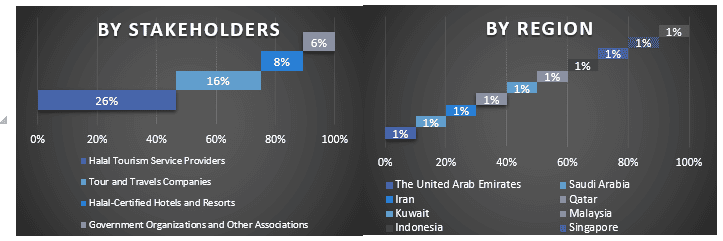
Inżynieria rynku
Zastosowano technikę triangulacji danych, aby ukończyć ogólne oszacowanie rynku i uzyskać precyzyjne dane statystyczne dla każdego segmentu i podsegmentu globalnego rynku turystyki halal. Dane zostały podzielone na kilka segmentów i podsegmentów po przestudiowaniu różnych parametrów i trendów w rodzaju, typie turysty i regionach globalnego rynku turystyki halal.
Główny cel badania globalnego rynku turystyki halal
W badaniu wskazano obecne i przyszłe trendy rynkowe globalnego rynku turystyki halal. Inwestorzy mogą uzyskać strategiczne spostrzeżenia, na których mogą opierać swoje decyzje dotyczące inwestycji na podstawie analizy jakościowej i ilościowej przeprowadzonej w badaniu. Obecne i przyszłe trendy rynkowe określiły ogólną atrakcyjność rynku na poziomie regionalnym, zapewniając uczestnikom branżowym platformę do wykorzystania niewykorzystanego rynku w celu skorzystania z przewagi pioniera. Inne ilościowe cele badań obejmują:
- Analiza obecnej i prognozowanej wielkości rynku turystyki halal pod względem wartości (USD). Ponadto analiza obecnej i prognozowanej wielkości rynku różnych segmentów i podsegmentów.
- Segmenty w badaniu obejmują obszary rodzaju, typu turysty i regionów.
- Zdefiniowanie i analiza ram regulacyjnych dla turystyki halal
- Analiza łańcucha wartości związanego z obecnością różnych pośredników, wraz z analizą zachowań klientów i konkurentów w branży.
- Analiza obecnej i prognozowanej wielkości rynku turystyki halal dla głównego regionu.
- Główne kraje regionów badanych w raporcie to Azja i Pacyfik, Europa, Ameryka Północna i reszta świata
- Profile firm na rynku turystyki halal oraz strategie rozwoju przyjęte przez uczestników rynku w celu utrzymania szybko rozwijającego się rynku.
- Dogłębna analiza branży na poziomie regionalnym
Najczęściej zadawane pytania FAQ
P1: Jaka jest obecna wielkość rynku turystyki halal i jego potencjał wzrostu?
P2: Jakie czynniki napędzają wzrost rynku turystyki halal?
Pytanie 3: Który segment ma największy udział w rynku turystyki halal ze względu na źródło?
P4: Jakie są główne trendy na rynku turystyki Halal?
P5: Który region zdominuje rynek turystyki halal?
Powiązane Raporty
Klienci, którzy kupili ten przedmiot, kupili również

